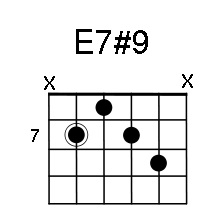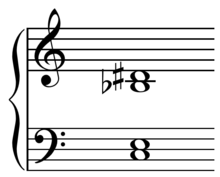- Hendrix chord
-
Hendrix chord Component intervals from root augmented ninth minor seventh perfect fifth major third root In music, the dominant 7♯9 chord[1] is sometimes known colloquially as the Hendrix chord or Purple Haze chord, nicknamed for guitarist Jimi Hendrix.[2][3] While this sonority has been previously used in jazz and related styles, this particular chord form got its nickname because it was a favorite of Hendrix, who did a great deal to popularize its use in mainstream rock music.[4]
The most notable Hendrix song that features the 7♯9 chord is "Purple Haze" (recorded 1967). The chord is also implied throughout "Foxy Lady" (1967)[5][6]. Both songs are from his 1967 album Are You Experienced?. This harmonic device is one of many factors that contribute to "the dirty, raw, metallic, angular sounds of...[these] Hendrix songs"[3]. The earliest recorded evidence of his use of the chord is on the Isley Brothers "Testify, Parts 1 and 2" (1964), one of the few known recordings he made in the years prior to his solo career in 1966.
Contents
Harmony and scales
It is an example of how Hendrix would embellish chords "to add new colours to the music, often derived from his own roots in black music".[3] "In essence," one author has written, the Hendrix chord is "the whole of the blues scale condensed into a single chord."[6]
"It has a 'funky' or 'bluesy' sound because of the friction generated between the major third and the augmented ninth,"[1] and may also be considered "jazzy"[8] rather than bluesy and, "the sharp nine tends to be edgier, bluesier, and meaner sounding [than the flat nine]."[9] While the dorian may be the scale most commonly used for the 7♯9, the mixed third allows flexibility including the use of mixolydian, aeolian, and other modes.[10] In jazz, 7♯9 chords, along with 7♭9 chords, are often employed as the dominant chord in a minor ii-V-I turnaround. For example, a ii V I in Cm could be played as: Dm7♭5 - G7♯9 - Cm7.
When performing "Voodoo Child (Slight Return)" live Hendrix later used not only E7♯9, the sharpened ninth chord on the tonic, but also D7♯9 and C7♯9 chords, the subtonic and submediant,[6] which would total nine and imply eleven notes, rather than only five.
Other uses
Though this chord was a favorite of Jimi Hendrix, it was not his exclusively and had been used in popular music as far back as the bebop era of the 1940s, notably on the Rachmaninoff-inspired introduction to Dizzy Gillespie and Charlie Parker's arrangement of the popular standard "All the Things You Are." Instances of this chord appear with some regularity in blues and rhythm-and-blues of the 1950s and 1960s, but guitarist Billy Butler’s use of the chord in Bill Doggett’s "Hold It" (1958) proved so memorable that musicians began referring to it as the "Hold It" chord.[citation needed] The chord is employed in the John Coltrane jazz standard "Blue Train".[citation needed] Use as a primary or tonic chord in funk and disco music of the seventies includes Heatwave's "Boogie Nights".[7]
The chord is favored by Pixies lead guitarist Joey Santiago, with D7♯, reminiscent of the opening to "A Hard Day's Night", opening and being called the "secret ingredient," to the song "Here Comes Your Man" and 'brutally scraped' F7♯9 featured on the chorus to "Tame" against the three chord rhythm guitar part's D, C, and F chords.[12]
The chord is present in the Mötley Crüe song "Dr. Feelgood" off the same title album during the main riff.[citation needed] It is used during the outro to Alice In Chains song "Would?".[citation needed]
The dominant 7♯9 chord was also used in impressionist classical music. A good example can be heard in Claude Debussy's Feuilles Mortes (Dead Leaves, 1913), where the unresolved, dissonant ninth chords (at least a, "C#7with a "split third" and added minor ninth"[13]) help create an, "utterly sad, desolate character," throughout the piece.[14][not in citation given (See discussion.)]
Further reading
- Hanford, John. "With the Power of Soul: Jimi Hendrix in Band of Gypsys" Ph.D. dissertation, University of Washington, 2003.
- van der Bliek, Rob. "The Hendrix Chord: Blues, Flexible Pitch Relationships, and Self-standing Harmony," Popular Music 26:2 (May 2007), pp 343–364.
Sources
- ^ a b c Isacoff, Stuart (1987). The 20-Minute Chords & Harmony Workout, p.111. ISBN 9780943748412.
- ^ (2007). The Complete Idiot's Guide to Rock Guitar Songs, p.58. ISBN 0739046284.
- ^ a b c Shapiro, Harry and Caesar Glebbeek (1995). Jimi Hendrix: Electric Gypsy, p.144. ISBN 0312130627.
- ^ "The 'Hendrix Chord'", http://www.fender.com/news/index.php?display_article=500
- ^ Roby, Steven (2002). Black Gold: The Lost Archives of Jimi Hendrix, p.32. ISBN 082307854X.
- ^ a b c Perry, John (2004). Jimi Hendrix's Electric Ladyland, p.120-121. ISBN 0826415717.
- ^ a b Stephenson, Ken (2002). What to Listen for in Rock: A Stylistic Analysis, p.84. ISBN 9780300092394.
- ^ Munro, Doug (2001). Jazz Guitar: Bebop and Beyond, p.58. ISBN 0757982816.
- ^ Eric Starr, Nelson Starr (2008). Everything Bass Guitar Book: From Lines and Licks to Chords and Charts - All You Need to Find Your Groove,[page needed]. ISBN 9781598694833.
- ^ Gill, Danny (2001). Practice Trax for Guitar[sic], p.13. ISBN 0634026216.
- ^ Radio: "Shiver down the backbone - Jimi Hendrix comes to Radio 3", The Spectator, by Kate Chisholm, Wednesday, 21st November 2007
- ^ Sisario, Ben (2006). Doolittle, p.82 and 90. ISBN 0826417744.
- ^ Bass, Richard (Autumn, 1994). "Models of Octatonic and Whole-Tone Interaction: George Crumb and His Predecessors", p.161, Journal of Music Theory, Vol. 38, No. 2., pp. 155-186. .
- ^ Bruhn, Siglund (2007). Images and Ideas in Modern French Piano Music, p.172 and 174. ISBN 9780945193951.
External links
 Media related to Hendrix chord at Wikimedia Commons
Media related to Hendrix chord at Wikimedia CommonsChords By type - Ninth
- Eleventh
- Thirteenth
- Upper structure
Added
/ omitted- Sixth
- Minor sixth
- Augmented sixth
- Power chord
- Lydian chord
- Seven six chord
By function Secondary- Secondary dominant
- Secondary leading-tone
- Secondary supertonic
With names - Elektra chord
- Farben chord
- Hendrix chord
- Mu chord
- Mystic chord
- Northern lights chord
- Petrushka chord
- Power chord
- Psalms chord
- So What chord
- Spider chord
- Tristan chord
- Viennese trichord
- Dream chord
Other - Common chord (music)
- Mixed interval
- Open chord
- Polychord
- Primary triad
- Quartal and quintal
- Slash chord
- Subsidiary chord
- Synthetic chord
- Tone cluster
Categories:- Altered chords
- Jimi Hendrix
Wikimedia Foundation. 2010.






